Nvidia GeForce RTX 5050 vs Intel Arc B580 Face Off: $249 graphics cards duke it out for budget gaming supremacy
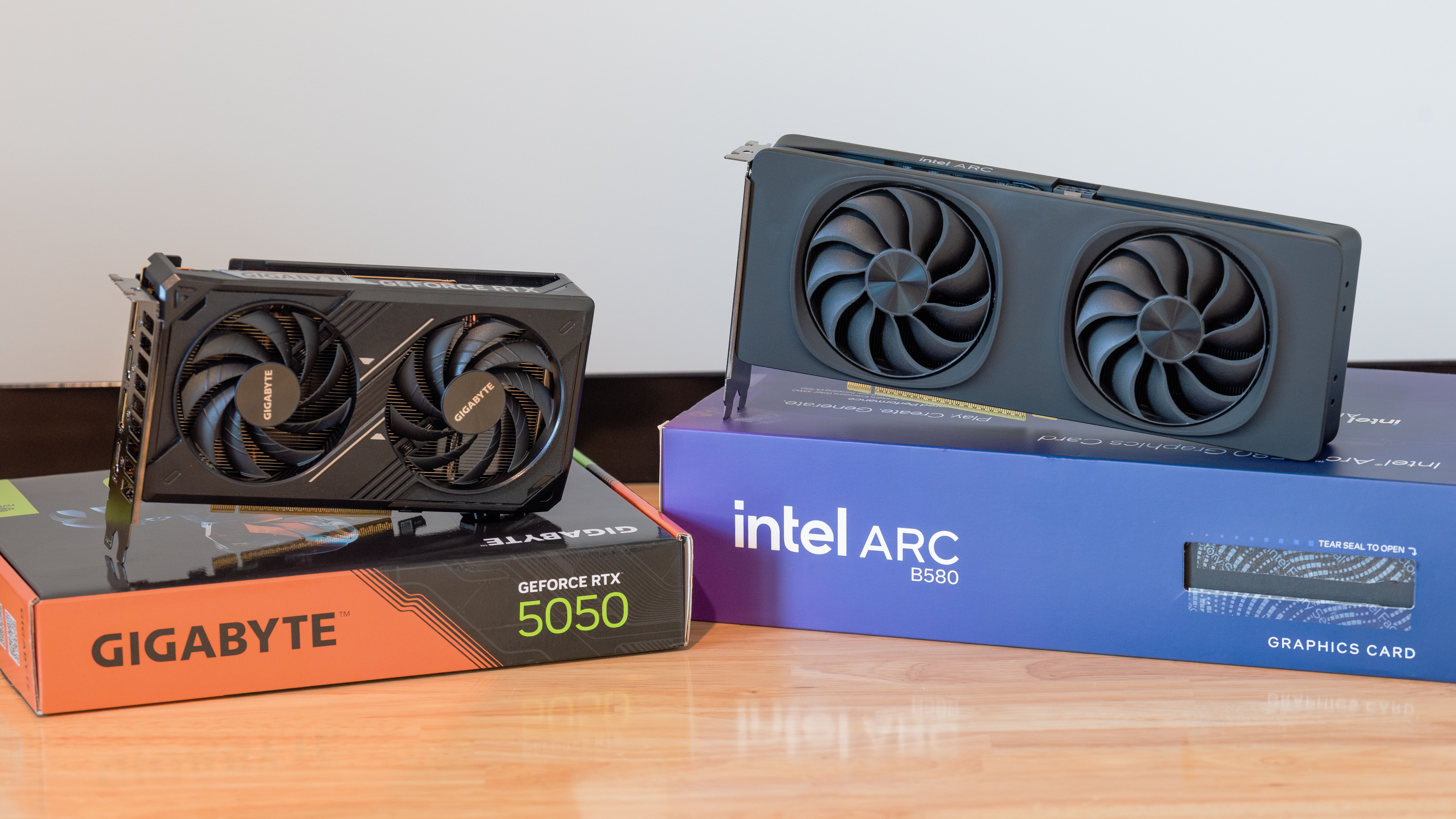
Back when Intel's Arc B580 graphics card launched about a year ago, it was one of the only options in town for folks who wanted a truly modern GPU for less than $300. Supply and demand apparently didn't balance out, however, because the B580 consistently sold for much more than its $249 list price for many months.
Now that Nvidia's GeForce RTX 5050 has arrived at a $249 MSRP (and you can find RX 9060 XT 8GB cards for well under $300), the B580 faces some stiff competition - and it's readily been available from stock for that same $249 of late.
This Black Friday season, however, RTX 5050 cards have dropped as low as $219, addressing one of our greatest complaints about that card's price-to-performance ratio. Is that enough to make the RTX 5050 a winner versus the B580?
Let's pit the Nvidia GeForce RTX 5050 vs Intel Arc B580 head-to-head and see which one is better positioned to win your gaming dollars.
Rasterization
Raster gaming performance
At 1080p, where most gamers shopping in this price class will likely play, you can barely fit a nanosheet transistor between the Arc B580 and the RTX 5050 for raster gaming performance across our 12-game test suite.
At 1440p, the Arc B580's 12GB of VRAM lets it shine, while the RTX 5050 falls significantly behind. The B580 also maintains a relatively strong standing at 4K while the RTX 5050 falls down the charts (even though we wouldn't recommend either of these cards for 4K gaming).
⭐ Winner: Arc B580, but check the games you like to play for performance pitfalls if possible
Get Tom's Hardware's best news and in-depth reviews, straight to your inbox.
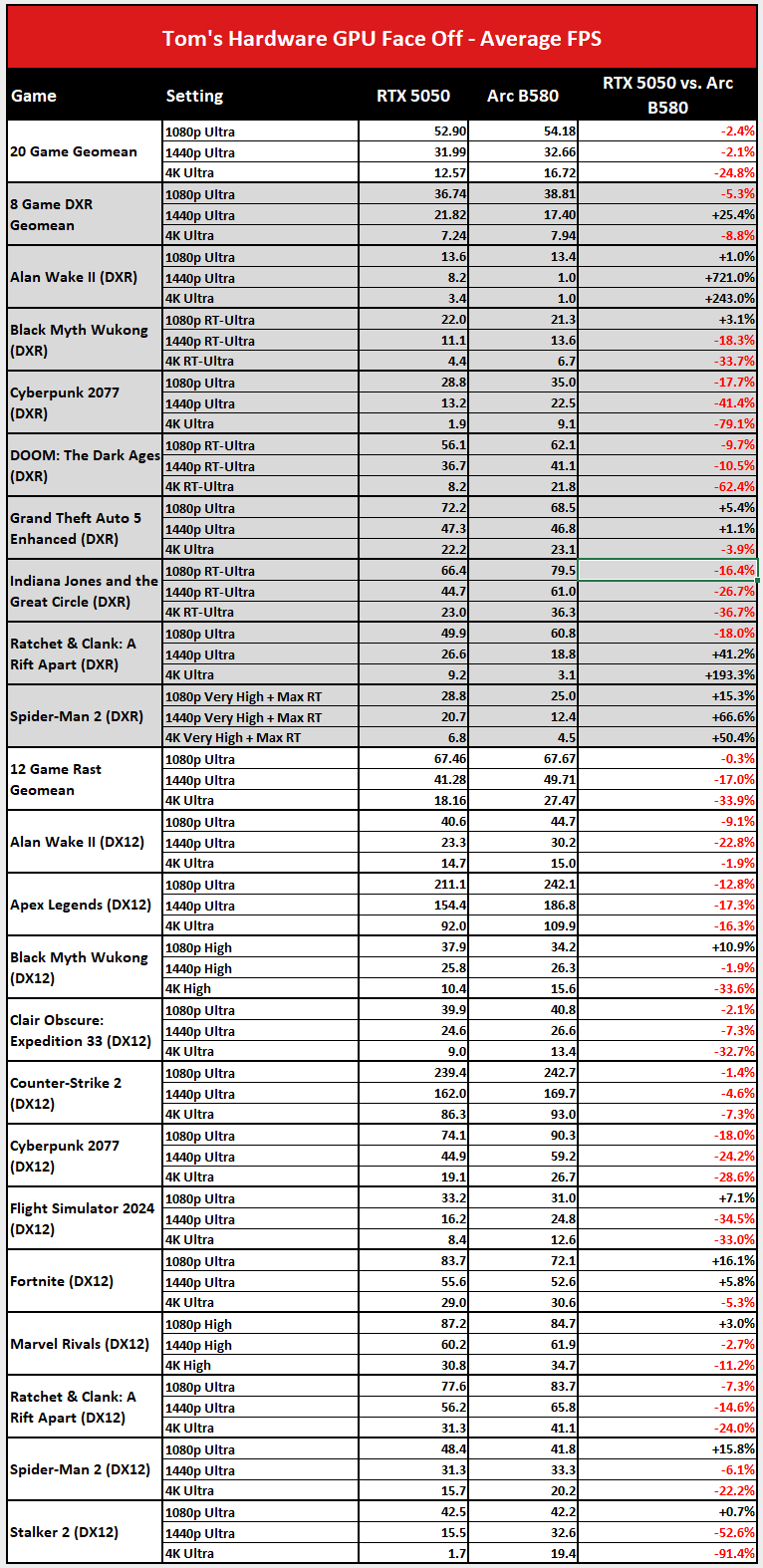

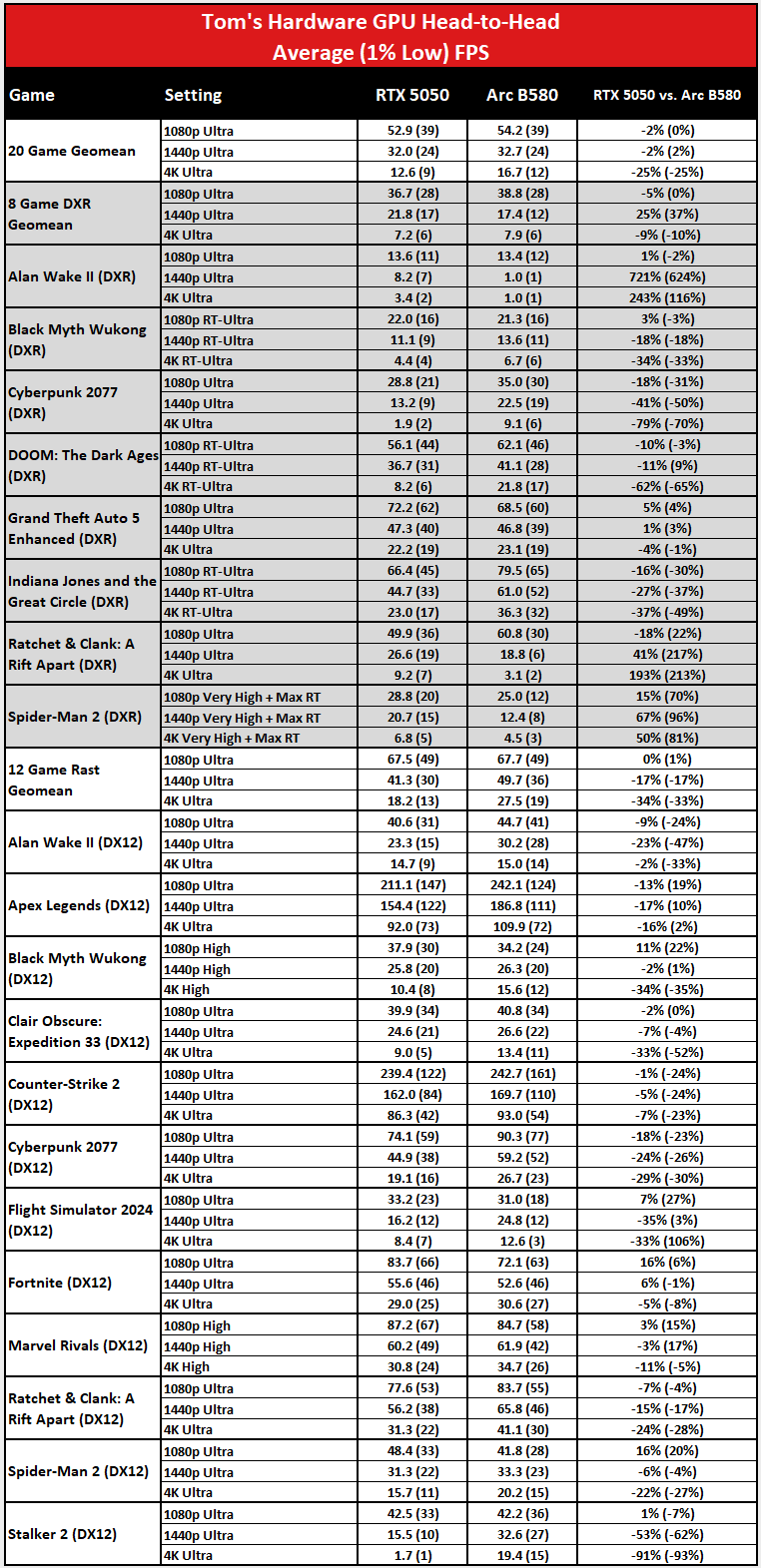

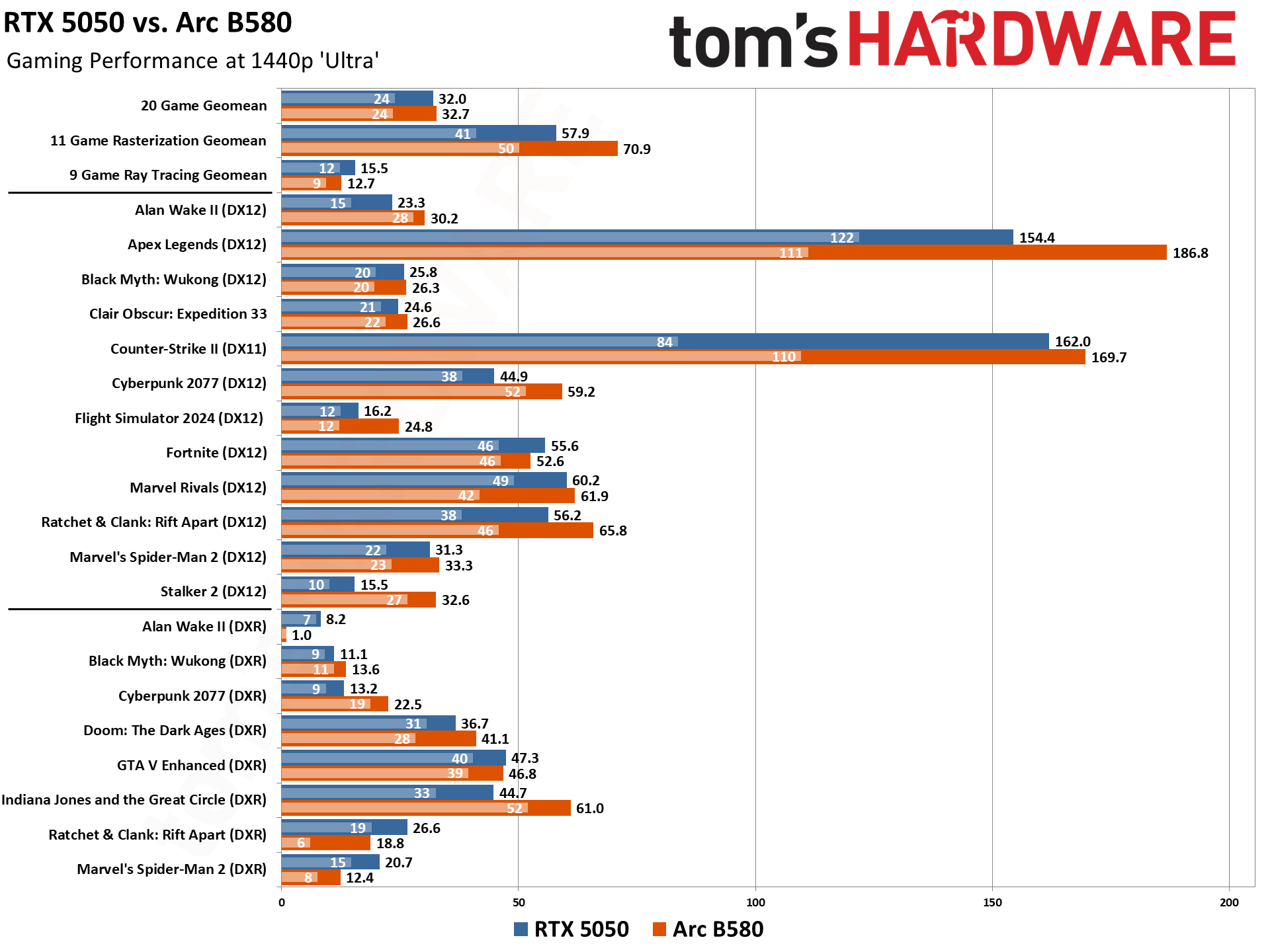

Ray-tracing
Ray-traced gaming performance
Much as with our raster results, the RTX 5050 and the Arc B580 are neck and neck at 1080p across our eight-game RT test suite. At 1440p, the RTX 5050 pulls ahead (possibly thanks to Blackwell's more mature RT architecture).
All that said, you shouldn't buy either of these cards purely for RT performance (except in less demanding RT games like Doom: The Dark Ages, Indiana Jones and the Great Circle, or GTA V Enhanced.) For a good RT baseline at 1080p, you really want an RTX 5060 Ti 16GB.
⭐ Winner: Tie (but neither of these cards are really built for hardcore RT)
Power
Power efficiency

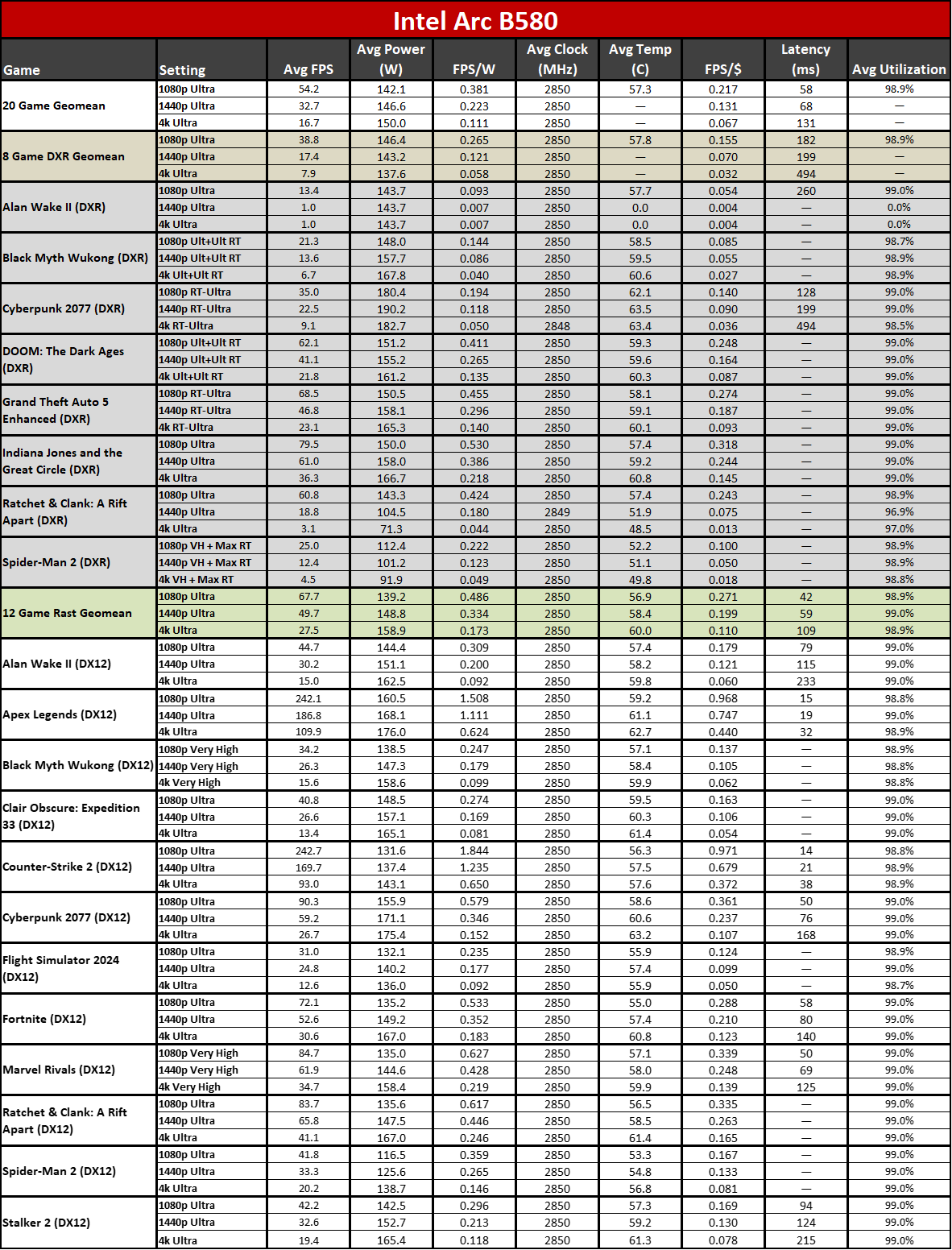
While the 5050 and B580 are neck-and-neck in performance at 1080p in raster titles, the GeForce card draws substantially less power to deliver roughly the same number of frames on average, and so it naturally ends up being more efficient in frames per watt. Even at 1440p, where the 5050 falls behind in raster, its lower power draw still lets it stay slightly more efficient than the B580.
⭐ Winner: RTX 5050
Upscaling
Upscaling and framegen
As a Blackwell card, the RTX 5050 gets all the latest DLSS 4 goodness, from the latest transformer-powered upscaling model to Multi Frame Generation. DLSS upscaling remains best in class, and we're fans of MFG when it's implemented well. DLSS upscaling is in pretty much every game that needs it, and if a game hasn't implemented the DLSS 4 transformer model yet, you can generally force it on via the Nvidia App to get an image quality boost.
The issue is that both MFG and DLSS upscaling require chunks of VRAM to work their magic, and if you're already pushing the limits of the 5050's 8GB of VRAM, as you often will be with the latest AAA games, MFG might not work as expected.
That reality makes the RTX 5050 less appealing than other Blackwell cards for cutting-edge gaming, but if you only play popular esports or battle royale titles that don't pressure VRAM much, you might not care.
The Arc B580 can take advantage of the best version of Intel's XeSS upscaler, which we generally prefer to AMD's cross-platform FSR where it's available. XeSS 1.x is in 324 games by our latest count, meaning you have a decent chance of finding it in a settings menu. Unfortunately, the latest XeSS 2 with framegen support is only in 44 games, and that number hasn't budged for a while.
Those titles will receive XeSS Multi Frame Gen support at some point in the future (at the Panther Lake launch in January, if we had to guess), either through native integration or through an app override, but Intel needs to get its latest tech into way more titles at a much faster pace if it wants to keep up with Nvidia. You can, of course, use AMD's FSR upscaling and framegen on the B580, where it's available, but FSR upscaling often looks worse than XeSS, so it's not as much of an advantage as you might hope.
⭐ Winner: RTX 5050
Pro apps
Pro apps and content creation
It's difficult to make an overall judgment about content creation and pro app performance. Unlike gaming, where frames per second can easily be distilled into a geomean, pro users are generally only using one app (or suite of apps) to do their work, and performance in that app can make or break an entire purchase.
We haven't tested the RTX 5050 against our full pro app and content creation suite yet, but in our last full test, the comparable RTX 4060 took home the crown in 11 tests versus the Arc B580's seven wins.
Going purely on experience, we know that Nvidia has basically limitless cash and resources to ensure that more or less every application works well with its products (witness its Studio driver program). At this price point, outright performance doesn't matter as much as stability and compatibility do, and we would give the nod to Nvidia there.
⭐ Winner: RTX 5050
Drivers and software
Drivers and software
Nvidia's Game Ready drivers reliably appear alongside the latest game releases, and Nvidia has a history of quickly deploying hotfixes to address specific show-stopping issues.
As we just noted, games aren’t the only place where drivers matter. Nvidia’s massive financial advantage over the competition means that non-gamers who still need GPU acceleration, like those using Adobe or other creative apps, can generally trust that their GeForce card will offer a stable experience with that software.
The Nvidia App (formerly GeForce Experience) includes tons of handy features, like one-click settings optimization and game recording tools. Nvidia also provides useful tools, like Broadcast, free of charge for GeForce RTX owners.
Intel has kept up a steady pace of new driver releases with support for the latest games, though broader app support may be a question mark. Intel Graphics Software has a slick enough UI and an everything-you-need, nothing-you-don't feature set for overclocking and image quality settings. We wouldn't choose an Arc card based solely on Intel's software support, but the company has proven its commitment to maintaining its software alongside its hardware. Still, though, Nvidia's track record on drivers and software is hard to beat.
⭐ Winner: RTX 5050
VR
Virtual reality
While VR hasn't changed the world to the degree its boosters once promised it would, the enduring popularity of apps like Beat Saber and VRChat means that we should at least give it a cursory look here.
This one is easy: the RTX 5050 boasts VR support, and the Arc B580 doesn't. Intel has never said whether or when it intends to support VR HMDs with its graphics cards, so until that changes, we have to give the win to Nvidia by default.
⭐ Winner: RTX 5050
Pricing and value
Pricing and value
The Arc B580 launched at an ostensible $249.99 MSRP, but for many months after its launch, prices for both Intel's Limited Edition card and partner cards settled well above that suggested price, dampening Intel's budget-friendly gaming story for the B580. Late this summer, prices finally settled within a few bucks of MSRP on more B580 cards (around the time of the RTX 5050 launch), and they've basically stayed there since, making the B580 a better value of late than it was at launch.
The RTX 5050 has been readily available at its $249 MSRP ever since its launch, but going by the results we saw in our review, $229 would be a fairer price for this card given its performance delta with the next card up the Blackwell stack: the $299 RTX 5060.
Which of these cards is a better value, dollar-for-dollar? We think that the RTX 5050's widespread support for DLSS 4 upscaling, better power efficiency, and strong 1080p gaming performance are all hard to ignore.
The Arc B580's 12GB of VRAM is situationally useful if you're trying to game at 1440p on a budget, but Intel's still-nascent XeSS integration base, lower power efficiency, and less mature software ecosystem swing the needle back toward the RTX 5050 here. Just not by that much.
⭐ Winner: RTX 5050
Verdict
RTX 5050 vs Arc B580 Verdict
| Row 0 - Cell 0 | RTX 5050 | Arc B580 |
Raster gaming performance | Row 1 - Cell 1 | ❌ |
Ray-traced gaming performance | ❌ | ❌ |
Power efficiency | ❌ | Row 3 - Cell 2 |
Upscaling and framegen | ❌ | Row 4 - Cell 2 |
Pro apps and content creation | ❌ | Row 5 - Cell 2 |
Drivers and software | ❌ | Row 6 - Cell 2 |
Virtual reality | ❌ | Row 7 - Cell 2 |
Pricing and value | ❌ | Row 8 - Cell 2 |
Total | 7 | 2 |
We ask a lot of our graphics cards these days. You're not just buying a card and a driver. You're buying into an entire software stack and developer relations effort that actually lets you take advantage of all the features your GPU vendor promises. And you want all those features to just work when you sit down to enjoy your limited gaming time.
At MSRP, the $249 RTX 5050 still feels a bit overpriced for the performance it delivers. But in the world we live in, where graphics card buyers have exactly two options at this price point, it's a better general pick than Intel's Arc B580. The B580 can steal a win from the 5050 here and there, but the whole Arc enchilada just isn't up to what Nvidia is offering.
There are a couple specialized use cases where the Arc B580 still shines. If you need to do 1440p gaming on a budget, or you're big into AI, the B580's extra VRAM (and, apparently, better utilization of its compute resources at higher resolutions) lets it pull ahead. But we don't feel like those wins are worthy of a general recommendation.
As we noted in our review, the real spoiler for the RTX 5050 and the Arc B580 is AMD's Radeon RX 9060 XT 8GB, which has consistently been available for $269 on Amazon for some time, and for as little as $249 during the 2025 Black Friday deals season. It delivers much higher raster frame rates at 1080p than the RTX 5050 and Arc B580 for just a bit more money.
In raster games that aren't limited by VRAM, which describes many of today's most popular titles on the PC, the 9060 XT wipes the floor with everything further down the ladder, and it isn't even close.
Those pricing pressures have led to relatively deep discounts on the RTX 5050 of late. As Black Friday 2025 gets into full swing, we've seen prices for some of these cards fall as low as $219.99, which makes the RTX 5050's shortcomings easier to accept for budget gaming.
Transient discounts aside, our judgment stands: if you only have $250 to spend and can't spend a dollar more, our nod has to go to the RTX 5050 until something better comes along.
🏆 Winner: RTX 5050

As the Senior Analyst, Graphics at Tom's Hardware, Jeff Kampman covers everything to do with GPUs, gaming performance, and more. From integrated graphics processors to discrete graphics cards to the hyperscale installations powering our AI future, if it's got a GPU in it, Jeff is on it.
-
Crazyy8 The difference is small enough between the two that people are going to buy the RTX 5050, turn on DLSS Quality, and get the same or better performance as the B580 with virtually the same image quality. The RTX 5050 can even use higher DLSS modes or 4xFG and get "4090 performance, at $259********". Plus, you are guaranteed a decade or more of driver support, CUDA, blender and other application comparability, DLSS updates, et cetera, AND Nvidia is a name brand in the GPU market.Reply
Things aren't looking so good for Intel right now, if you buy Intel you risk driver support ending earlier than Nvidia, more so if Intel flops further in the GPU and CPU market. Their DLSS isn't as good as Nvidia's, worse frame gen, no cuda, worse AI support/performance, et cetera++++++.
All of this isn't even accounting for the soon to be rising GPU cost due to RAM/DRAM shortage.
The only thing going for Intel is the fact they have better raw performance than Nvidia while being such a new player, but that isn't really hard considering the state of Nvidia's budget lineup.
I hope Intel can compete against Nvidia, but I don't see many people buying Intel's GPUs for now. -
Marlin1975 So B580 better for gaming but a bunch of other stuff, most do not care about, goes to Nvidia.Reply
OK... got it. -
logainofhades If I was forced to buy an 8gb GPU, I would spend the extra $25 and get an RX 9060xt. While improvements have been made, the B580 still suffers from CPU overhead issues.Reply
PCPartPicker Part List
Video Card: Gigabyte GAMING OC Radeon RX 9060 XT 8 GB Video Card ($274.99 @ Amazon)
Total: $274.99
Prices include shipping, taxes, and discounts when available
Generated by PCPartPicker 2025-11-25 14:01 EST-0500 -
Gururu It's interesting that I must be the only one that runs 1440 high settings exclusively since I purchased the B580. Never even tried 1080. If the 5050 is good at 1440 too, then we should see these tests because I suspect a lot of people will be doing 1440 on these cards.Reply